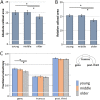Parallel but independent reduction of emotional awareness and corpus callosum connectivity in older age
- PMID: 30596756
- PMCID: PMC6312250
- DOI: 10.1371/journal.pone.0209915
Parallel but independent reduction of emotional awareness and corpus callosum connectivity in older age
Abstract
Differential functional specialization of the left and right hemispheres for linguistic and emotional functions, respectively, suggest that interhemispheric communication via the corpus callosum is critical for emotional awareness. Accordingly, it has been hypothesized that the age-related decline in callosal connectivity mediates the frequently demonstrated reduction in emotional awareness in older age. The present study tests this hypothesis in a sample of 307 healthy individuals between 20-89 years using combined structural and diffusion-tensor magnetic resonance imaging (MRI) of the corpus callosum. As assumed, inter-hemispheric connectivity (midsagittal callosal area and thickness, as well as fractional anisotropy, FA) and emotional awareness (i.e., increase in externally-oriented thinking, EOT; assessed with the Toronto Alexithymia Scale, TAS-20) were found to be reduced in older (> 60 years) compared to younger participants. Furthermore, relating callosal measures to emotional awareness, FA in the genu of the corpus callosum was found to be negatively correlated with EOT in male participants. Thus, "stronger" structural connectivity (higher FA) was related with higher emotional awareness (lower EOT). However, a formal mediation analysis did not support the notion that age-related decline in emotional awareness is mediated by the corpus callosum. Thus, the observed reduction of emotional awareness and callosal connectivity in older age likely reflects parallel but not inter-dependent processes.
Conflict of interest statement
The authors have declared that no competing interests exist.
Figures





Similar articles
-
Corpus Callosum Diffusion Anisotropy and Hemispheric Lateralization of Language in Patients with Brain Arteriovenous Malformations.Brain Connect. 2021 Aug;11(6):447-456. doi: 10.1089/brain.2020.0853. Epub 2021 Apr 15. Brain Connect. 2021. PMID: 33356845
-
Corpus callosal microstructural integrity influences interhemispheric processing: a diffusion tensor imaging study.Cereb Cortex. 2005 Sep;15(9):1384-92. doi: 10.1093/cercor/bhi020. Epub 2005 Jan 5. Cereb Cortex. 2005. PMID: 15635059 Clinical Trial.
-
On the role of the corpus callosum in interhemispheric functional connectivity in humans.Proc Natl Acad Sci U S A. 2017 Dec 12;114(50):13278-13283. doi: 10.1073/pnas.1707050114. Epub 2017 Nov 28. Proc Natl Acad Sci U S A. 2017. PMID: 29183973 Free PMC article.
-
How does the corpus callosum mediate interhemispheric transfer? A review.Behav Brain Res. 2011 Sep 30;223(1):211-21. doi: 10.1016/j.bbr.2011.04.018. Epub 2011 Apr 21. Behav Brain Res. 2011. PMID: 21530590 Review.
-
Functional implications of age-related atrophy of the corpus callosum.Neurosci Biobehav Rev. 2025 Feb;169:105982. doi: 10.1016/j.neubiorev.2024.105982. Epub 2024 Dec 17. Neurosci Biobehav Rev. 2025. PMID: 39701505 Review.
Cited by
-
Comparative morphology of the corpus callosum across the adult lifespan in chimpanzees (Pan troglodytes) and humans.J Comp Neurol. 2021 May 1;529(7):1584-1596. doi: 10.1002/cne.25039. Epub 2020 Sep 26. J Comp Neurol. 2021. PMID: 32978976 Free PMC article.
-
Keeping in Touch with Mental Health: The Orienting Reflex and Behavioral Outcomes from Calatonia.Brain Sci. 2020 Mar 22;10(3):182. doi: 10.3390/brainsci10030182. Brain Sci. 2020. PMID: 32235727 Free PMC article. Review.
-
Handedness and midsagittal corpus callosum morphology: a meta-analytic evaluation.Brain Struct Funct. 2022 Mar;227(2):545-559. doi: 10.1007/s00429-021-02431-4. Epub 2021 Dec 1. Brain Struct Funct. 2022. PMID: 34851460 Free PMC article. Review.
References
-
- Coffey E, Berenbaum H, Kerns J. The dimensions of emotional intelligence, alexithymia, and mood awareness: Associations with personality and performance on an emotional stroop task. Cognition & Emotion. 2003;17(4):671–9. - PubMed
-
- Gohm CL, Clore GL. Individual differences in emotional experience: Mapping available scales to processes. Personality and Social Psychology Bulletin. 2000; 26(6):679–97.
Publication types
MeSH terms
LinkOut - more resources
Full Text Sources
Medical
Research Materials

